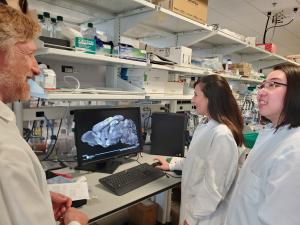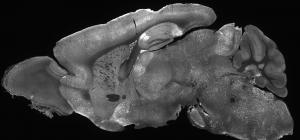Scientists Fix Genetic Defect in Mice Tied to Brain Disorders That Include Autism and Epilepsy

Allen Institute researchers Boaz Levy, Ph.D., associate investigator; Meagan Quinlan, Ph.D., scientist; Rong Guo, Ph.D., scientist (Photo credit: Allen Institute/Peter Kim)
Gene therapy successfully reduced epileptic activity, hyperactivity and risk-taking behaviors tied to SYNGAP1-related disorders
The findings, recently published in the journal Molecular Therapy, represent the first successful gene supplementation therapy for SRDs in which an adeno associate virus (AAV) was used to deliver a working copy of the SYNGAP1 gene into brain cells. AAVs are non-replicating viruses that act like delivery trucks carrying therapeutic cargo, in this case the SYNGAP1 gene, into cells that need it.
“Gene supplementation is providing a functional new copy of a defective gene, a strategy that has great potential for correcting diseases where a gene is completely missing or where a single copy of a gene is lost,” said Boaz Levi, Ph.D., associate investigator at the Allen Institute and senior author of the study. “This provides a clear demonstration that SYNGAP1-related disorders can be treated with a neuron-specific gene supplementation strategy. It’s an important milestone for the field that provides hope for those who suffer from this class of severe neurological diseases.”
[What Were the Most Important Findings?]
The new gene therapy improved a broad range of disease symptoms, nearly eliminating epileptic brain activity and correcting hyperactive behavior and risk-taking tendencies characterized by SRDs. The treatment also substantially restored normal brain wave patterns, which is significant because abnormal brain rhythms in SRD patients are tied to cognitive dysfunction affecting learning, memory, and attention.
Notably, the study also revealed something important about the timing of when this therapy was given: Researchers treated juvenile mice, an age corresponding to when children are usually diagnosed. At this stage, the mice’s symptoms dramatically improved, suggesting that this gene therapy could still be effective even after symptoms begin. This encouraging finding offers hope that treatment may help restore normal brain function in children with SRDs.
[What Are the Practical Implications?]
This discovery is an encouraging development for families affected by SRDs. Right now, there are few treatment options and drugs available for families to find relief, and those that are available are limited to managing severe symptoms without addressing the root cause. This new research, if successful in human trials, could lead to new therapies that alleviate symptoms by targeting the genetic origins of disease rather than addressing symptoms alone.
[How Did Researchers Do It?]
Scientists faced a technical barrier in designing the new therapy. The defective copy of the SYNGAP1 gene needs to be replaced, but this gene is too large to fit into AAV delivery systems. In this case, researchers built the oversized gene and packaged it into the AAV, much like loading a truck filled with more luggage than anyone thought it could hold. Surprisingly, it all fit, and the therapy was successfully delivered into targeted brain cells.
While clinical trials are still needed, the strong evidence and data in this study suggest that effective treatment for SRDs and their devastating symptoms may be within reach. The range of therapeutic benefits was also significant—addressing seizures, behavior, and brain function simultaneously.
This hopeful development for science represents the kind of transformative potential that patients and families desperately need for this debilitating class of brain diseases.
Liz Dueweke
Allen Institute
+1 206-519-8527
email us here
Legal Disclaimer:
EIN Presswire provides this news content "as is" without warranty of any kind. We do not accept any responsibility or liability for the accuracy, content, images, videos, licenses, completeness, legality, or reliability of the information contained in this article. If you have any complaints or copyright issues related to this article, kindly contact the author above.


